As Theodore Bergmann and Louis Schmeisser embarked on the process of perfecting and improving their production pistols, they used a numbering system to identify the different models that were made. There are also model years associated with each major design change, and that can lead to some confusion in trying to understand what guns are what. We looked yesterday at the initial 1892/1893 model, which did not have a number (and was in many ways just a prototype). Today, we have the Number 1 pistol, which is also the 1894 model.
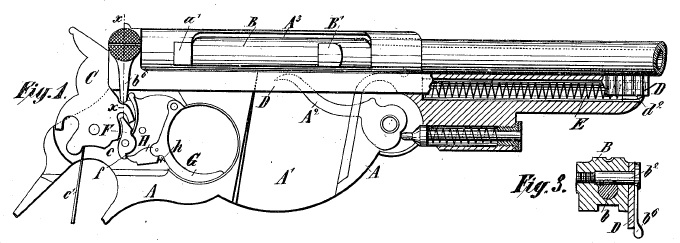
While the model 1894 incorporated a number of improvements over the initial design, it also had some fairly serious flaws, and was not made in large numbers. Literature on the early Bergmanns is pretty sparse, and what there is often raises more question than it answers. In R.K. Wilson’s Textbook of Automatic Pistols, for instance, the 1894 and 1896 guns are lumped together without any differentiation, when they are clearly different from each other. This has led folks like Ed Buffaloe to suggest that the 1894 was essentially a prototype as well. I’m pretty sure he’s right; that the 1894 was a transitional model. We do know that (according to Reinhart and am Rhyn, anyway) the Model 1894 was tested by the Swiss military in 1894 and 1895, which suggests that the results of those tests led to the 1896 changes.
Anyway, I should discuss what the 1894 actually was, shouldn’t I?
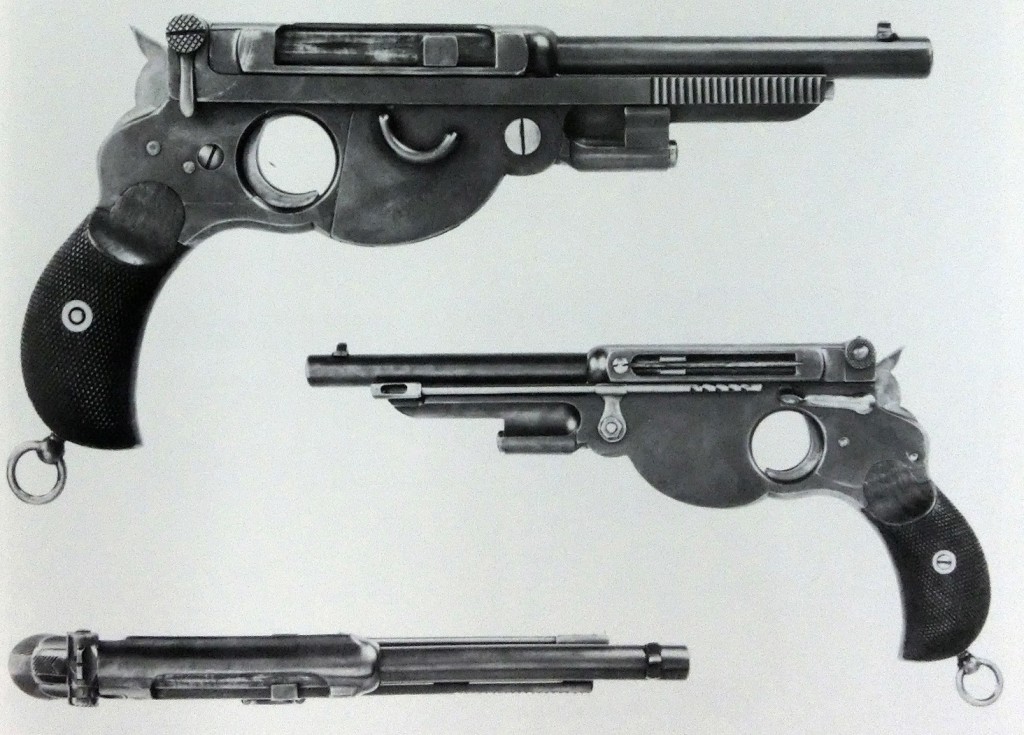
The major change from 1893 to 1894 was a redesign of the operating mechanism from a somewhat odd delayed blowback system to a simple direct blowback. This reduced the expense and complexity of the pistol, although it did limit the power of the cartridge that could be used in the pistol. Of course, in 1894 there weren’t many self loading pistols capable of firing anything but fairly mild cartridges, so this wasn’t really a problem for the commercial market. In fact, the specific cartridge used by the Bergmann No.1 is subject to debate. The ones sent to Switzerland were in 7.5mm, probably the standard revolver cartridge still. They were also manufactured (at least in prototype) for a 5mm cartridge – we have photos of an un-serialed such example from a recent James Julia auction. This particular gun came with a folding trigger.
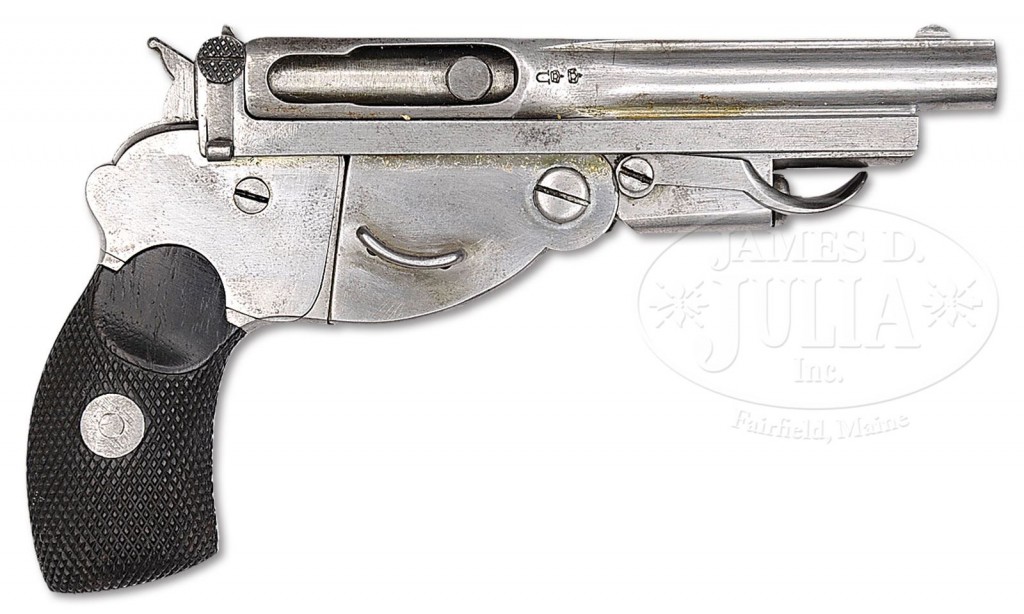
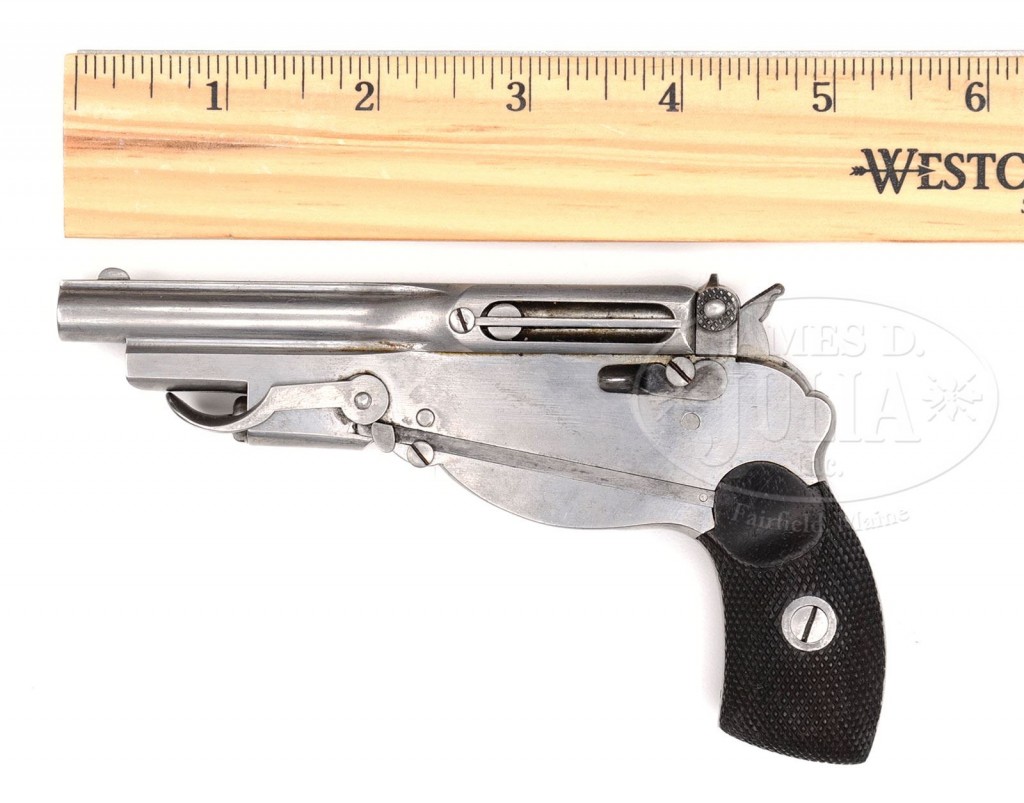


One of the main distinguishing characteristics of the model 1894 is the location of the recoil spring below the barrel. This is evident in the patent granted to Louis Schmeisser (granted in 1893 in Germany and England, and 1895 in the United States), and can also be seen in the above toolroom gun and the surviving photos of the Swiss trials gun. When the design evolved into the 1896 pattern, the recoil spring would be moved behind the bolt. The significant difference in size between the military trials gun and the 5mm toolroom gun suggests that Bergmann was interested in marketing to both military and civilian buyers by this time, where the 1893 had not been made with civilian sales in mind. Of course, given the small numbers and lack of surviving information, it is also possible that the civilian model of the 1893 has simply been lost to history.
One final distinctive feature of the model 1894 is its lack of an extractor. It is not well known among casual shooters that a blowback mechanism will generally extract without trouble, since there is still significant chamber pressure when the case begins moving backwards (on locked-breech pistols, the pressure has dissipated and movement is instead based on inertia in the slide or barrel). Bergmann and Schmeisser exploited this fact and further simplified the early pistols by leaving the extractor off. Early Bergmann cartridges, like the 5mm used in the gun above, indeed had no extractor groove as it was unnecessary. This system worked reasonably well in ideal conditions, and all the 1894 pistols were built this way. It is not clear how the Swiss test pistols were made, given that their 7.5mm ammunition was rimmed for revolver use – I suspect they also had no extractor and simply sized the boltface to fit the rim.
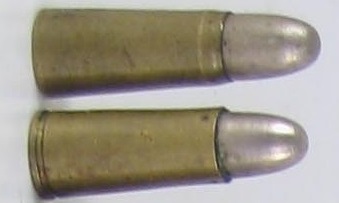
Loading the 1894 was exactly the same as the 1893 – a 5-round clip was laid into the magazine after pivoting the magazine cover plate open. This magazine functioned much like a Mannlicher-style system (Steyr M95, Carcano, etc), as a spring loaded follower finger would push the cartridges up. When the last cartridge was chambered, the now-empty clip would fall out through an opening in the bottom of the magazine. According to Wilson, it was possible to manually load the magazine from the side without the clip by simply laying the rounds in position, but that with or without it the system was fairly prone to misfeeding.
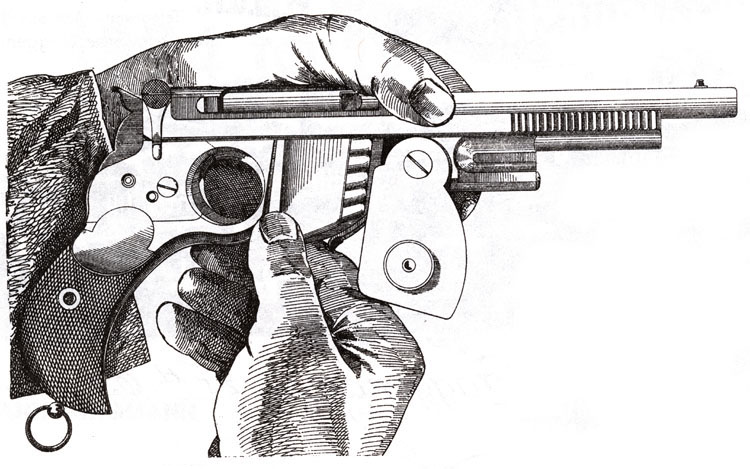
Ultimately, a very small number of No.1 model pistols were made and sold before further the design was further modified to the 1896 type – which would finally be a commercial success for Bergmann. Today they are probably the rarest major type of Bergmann.
Technical Specs
Caliber: 7.5mm Swiss Revolver, 5mm Bergmann, possibly also 6.5mm Bergmann and 8mm Bergmann
Clip Capacity: 5 rounds
Overall Length (Swiss model): 11 in (280mm)
Overall Length (toolroom model): 5.5 in (140mm)
Barrel Length (Swiss model): 5.35 in (136mm)
Barrel Length (toolroom model): 2.75 in (70mm)
Weight (Swiss model): 36.3 oz (1.03kg)
Weight (toolroom model): 8.5 oz (240g)
Action: Straight blowback
Patents
US Patent 547,454 (L. Schmeisser, “Recoil Operated Firearm”, October 8, 1895)
References
Ezell, Edward C. Handguns of the World. Stackpole Books, New York, 1981.
Reinhart, Christian and am Rhyn, Michael. Fastfeuerwaffen II.
Wilson, R.K. Textbook of Automatic Pistols. Samworth, 1934 (reprinted by Wolfe Publishing, Prescott AZ, 1990).


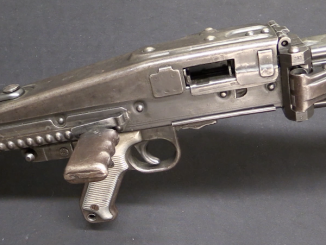
Info from В.Е. Маркевич Ручное огнестрельное оружие:
Bergmann 1894 was chambered in 6,5mm.
Effects of Swiss trials:
Bullet from Bergmann 1894 penetrate 148mm of pine wood @ distance of 6m
Bullet velocity: 236m/s (measured 8m from muzzle)
For comparison Schmidt 1882 revolver with Model 1886 ammo:
Bullet from Schmidt 1882 penetrate 92mm of pine wood @ distance of 6m
Bullet velocity: 215m/s (measured 10m from muzzle)
Bergmann pistol work satisfactorily.
Cartridge was smokeless, grooveless, bullet melchior-jacketed.
Маркевич describe the 5mm as “Bergmann 1895”.
Here http://www.municion.org/bergmann/6_5x22_94.htm
you can see the ammo dimensions & original box of ammo.
If the information is accurate, those are pretty impressive penetration characteristics, especially considering the vintage of the gun and cartridge as well as the relatively low muzzle velocity. Many thanks for sharing!
So much for “concealment equals cover.” Small caliber bullets with high velocities are deemed “armor-piercing” by US law, even if they aren’t intended to smash through body armor. I don’t know why…
Here’s some lampshade-hanging about Hollywood physics from an anime, of all places:
“Thank God for these bulletproof tables they’ve got everywhere now.”
— Jigen, Lupin III (Geneon dub)
If Bergmann bullets from a pistol could punch through a table at the length of a bedroom, what hope is there for people trying to hide from bigger stuff? I mean, people in the movies erroneously use brick walls and cars to hide from assault rifles? Sure, the rounds could shatter or ricochet, but I would rather be safe than sorry.
Do not use foliage or brick walls to hide from old-school rifle-caliber heavy machine guns. Water-cooled Maxim guns in all variations would be able to chop down trees and anyone hiding behind them.
According to my dog-eared U.S. Army “Improvised Munitions” manual, here’s what it takes to stop 5.56mm ball at 10 feet; 1/2″ mild steel, 1″ structural aluminum, 14″ soft pine, 3″ gravel, 4″ dry sand (packed), 6″ wet sand or earth.
7.62 x 51 figures are; 1/2″, 1″, 22″, 4″, 5″, and 13″ respectively.
.50 BMG; 3/4″, 2″, 32″, 11″, 14″, 21″. (I believe these figures are a bit optimistic, especially the 3/4″ of mild steel.)
Pistol rounds aren’t quite up to that level, but some show pretty impressive performance. The 9mms and .357s tend to be the best (or worst, if you’re on the receiving end), but the joker in the deck is the 7.63 Mauser aka 7.62 Tokarev.
In most loadings, it exhibits penetration only marginally inferior to 5.56. The old Czech vz52 loading was especially nasty,having MVs in the 1500-1600 FPS range out of a pistol barrel; they made the Czech vz24 and 26 SMGs tactically equal to an M2 .30 carbine.
Back around the turn of the last century, small bullets at screamingly high velocities were very much “the thing” with both rifle and pistol cartridge designers. Witness the 6mm Lee Navy, a cartridge that was so far ahead of its time that the metallurgy of barrel making wasn’t up to dealing with it. Its progeny, the .220 Swift, is still around today.
Bergmann’s cartridge designs were typical of the era. As with auto accident investigations, the rule for cartridge design is; Speed Kills.
The difference is that in cartridges, you want speed, and the more the better.
cheers
eon
.50 BMG cartridge but which bullet – Ball, Armor-Piercing or other?
Well said. Please see my reply to Andrew Chern.
Daweo;
I’m assuming standard ball, 750 @~2800. According to a friend of mine who used to do this for a living on Uncle Sam’s payroll, the standard M2 ball .50BMG round will go through both sides of the old M3 halftrack out to about 400 yards. Armor on each side was 1/4″ homogenous steel, face-hardened, not “mild steel”. IHC-made HTs had .31″ sides. They were supposed to stop rifle-caliber bullets and small-to-medium fragmentation “products” without internal spalling.
Note that the late-war 480D-code 9mm round used by the Wehrmacht in the MP-40 had a sintered and hardened zinc-core bullet, left the muzzle of the SMG at over 1500 FPS, and would easily penetrate one side of the halftrack- and then bounce around inside the crew compartment a few times. (Ouch.)
Like I said, those figures for the fifty are optimistic, which leads me to wonder about the figures for the .223 and .308 as well.
Earl;
Thanks. I do my best. 😉
cheers to all
eon
Tell me about it. These myths continue to proliferate in spite of long-term proof to the contrary. One of the first things they taught us when I was a raw recruit ( God, that was a long time ago ) in the Army was the sheer fallacy of these commonly-held beliefs. We had a training session called “Penetration Of Materials”, during which it was amply demonstrated in no uncertain terms what various calibers of weapon, ranging from pistols through various infantry rifles and GPMG’s to HMG’s would do to assorted “protective” covers.
Hollywood and the general public really need a similar lesson in understanding what is real and what is not, otherwise the myths will perpetuate to the detriment of all concerned in one form or the other.
Thanks, Earl. As an engineer, I speculate that proper “cover” from firearms has to behave in a certain manner (engineering stress problem) when hit by an impulse force of considerable magnitude. That said, we have a dynamic problem because bullets have a lot of stress put on them during impact. The analytic model of the moment of impact between a 9 mm Parabellum FMJ round and a 10 inch cube of 1020 steel would be ridiculously complicated… or so I think. I haven’t set up the problem on paper yet…
Thanks, Andrew — now, that would be MOST interesting, to say the least! As an industrial/commercial hard-hat diver and underwater engineer, I have to constantly deal with structural stress factors, among a whole plethora of other concurrent factors ( hyperbaric, mechanical, electrical, life support, chemical, hydraulic, pneumatic, civil engineering, environmental, etc.), so I have a great appreciation and respect for the technical aspects and problems ( and the attendant implications ) associated with any form of engineering, firearms and ballistics included. If you do decide to look more deeply into the model(s) you mentioned, please keep us posted! 🙂
there are some nice pictures from a finite element simulation of a bullet impact up on Al Haral’s site
http://www.varmintal.com/aengr.htm
Concerning the folding-trigger model pictured above; how on earth could anyone be expected to reach the trigger with their firing-hand?
I haven’t handled one myself (yet), but I think that once folded down it wouldn’t be too hard to reach. It’s a pretty small gun, and the trigger comes a pretty long distance back when it’s in firing position. I have some photos of a No.2 with a folding trigger in that position which will be posting tomorrow – they should give you a better idea of the geometry.
Excellent. Looking forward to that picture, as I was thinking the same thing as DistalRadius. I was like, “Is that… Is that the trigger? It’d still be way far forward even folded down, what the heck is it doing there??”
O dear
I dont know who invented this mistake.
The numbering system is for the cartridges, not the pistols, that all hawe a year designation
That may be, but it still makes for an ideal way to distinguish between the models of pistol, especially the 1896 ones.
Not to be too to the point, why don’t you gentlemen do your own original research and not quote from third hand information which in many instances is misleading or just plain wrong.JA
I’m lucky enough to own a Bergmann Schmeisser 1894 pistol number 8 – it’s a beautifully engineered pistol and in exceptional condition